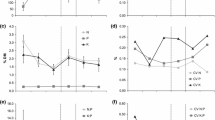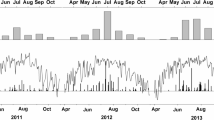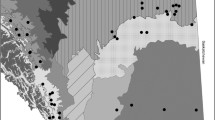Abstract
Background and aims
Modification in grazing intensity causes functional changes in permanent grasslands, e.g. in carbon (C) cycling. However, we still know little about how the soil organic C of permanent grasslands responds to grazing intensity.
Methods
In a grassland experiment with three levels of grazing intensity, we monitored root and rhizome C stocks, particulate organic C stocks, total soil C stocks, above-ground net primary production and plant species groups abundance over 7 years. A simple model was used to estimate the mortality of roots and rhizomes, decomposition rates of particulate organic C, and C fluxes under different grazing intensities.
Results
After 7 years, low grazing intensity and no grazing led to a modification in above-ground vegetation (production, plant species composition, nitrogen content) and a reduction in C transferred between roots and particulate organic matter fractions, while the C stocks of root and rhizomes, particulate organic matter and total soil were not significantly affected by grazing intensity. However, particulate organic C showed a strong interannual variability.
Conclusion
Particulate organic C could have reacted more slowly than expected to changes in grazing intensity, or a marked interannual variability of particulate organic C stocks, through an increase in decomposition rates in all the grazing treatments, could have slowed down the accumulation of particulate organic C and masked the effect of the grazing intensity treatments.






Similar content being viewed by others
Abbreviations
- AB:
-
Abandonment treatment
- ANPP:
-
Above-ground net primary production
- BNPP:
-
Below-ground net primary production
- AOM:
-
Aggregated organic matter
- AOC:
-
Aggregated organic carbon
- Cat−:
-
Low cattle grazing intensity treatment
- Cat+:
-
High cattle grazing intensity treatment
- cPOM:
-
Coarse particulate organic matter
- cPOC:
-
Coarse particulate organic carbon
- DMD:
-
Dry matter digestibility
- fPOM:
-
Fine particulate organic matter
- fPOC:
-
Fine particulate organic carbon
- LSU:
-
Livestock unit
- MRT:
-
Mean residence time
- NC:
-
Nitrogen content
- NIRS:
-
Near infrared spectroscopy
References
Alvarez G, Chaussod R, Loiseau P, Delpy R (1998) Soil indicators of C and N transformations under pure and mixed grass clover sward. Eur J Agron 9:157–172
Arrouays D, Deslais W, Badeau V (2001) The carbon content of top soil and its geographical distribution in France. Soil Use Manag 17(1):7–11
Bardgett RD, McAlistair E (1999) The measurement of soil fungal: bacterial biomass ratios as an indicator of ecosystem self-regulation in temperate meadow grasslands. Biol Fertil Soils 29:282–290
Bardgett RD, Wardle DA (2003) Herbivore-mediated linkages between aboveground and belowground communities. Ecology 84:2258–2268
Bardgett RD, Wardle DA, Yeates GW (1998) Linking above-ground and below-ground food webs: how plant responses to foliar herbivory influence soil organisms. Soil Biol Biochem 30:1867–1878
Bardgett RD, Bowman WD, Kaufmann R, Schmidt SK (2005) A temporal approach to linking aboveground and belowground ecology. Trends Ecol Evol 20:634–641
Baron VS, Mapfumo E, Dick AC, Naeth MA, Okine EK, Chanasyk DS (2002) Grazing intensity impacts on pasture carbon and nitrogen flow. J Range Manag 55:535–541
Bol R, Amelung W, Friedrich C, Ostle N (2000) Tracing dung derived carbon in temperate grassland using 13C natural abundance measurements. Soil Biol Biochem 32:1337–1343
Cambardella CA, Elliott ET (1992) Particulate soil organic matter changes across a grassland cultivation sequence. Soil Sci Soc Am J 56:777–783
Christensen BT (1996) Carbon in primary and secondary organo-mineral complexes. In: Carter MR, Stewart BA (eds) Structure and organic matter storage in agricultural soils. Press Inc, Boca Raton, FL, pp 97–165
Condron LM, Hopkins DW, Gregorich EG, Black A, Wakelin SA (2014) Long-term irrigation effects on soil organic matter under temperate grazed pasture. Eur J Soil Sci 65:741–750
De Deyn GB, Cornelissen JHC, Bardgett RD (2008) Plant functional traits and soil carbon sequestration in contrasting biomes. Ecol Lett 11:516–531
De Mazancourt C, Loreau M, Abbadie L (1998) Grazing optimization and nutrient cycling: when do herbivores enhance plant production? Ecology 79:2242–2252
Derner J, Schuman G (2007) Carbon sequestration and rangelands: a synthesis of land management and precipitation effects. J Soil Water Conserv 62:77–85
Dumont B, Carrère P, Ginane C, Farruggia A, Lanore L, Tardif A, Decuq F, Darsonville O, Louault F (2011) Plant-herbivore interactions affect the initial direction of community changes in an ecosystem manipulation experiment. Basic Appl Ecol 12:187–194
Dungait JAJ, Hopkins DW, Gregory AS, Whitmore AP (2012) Soil organic matter turnover is governed by accessibility not recalcitrance. Glob Chang Biol 18:1781–96
Frank D, Groffman PM (1998) Ungulate vs. landscape control of soil C and N processes in grasslands of Yellowstone National Park. Ecology 79:2229–2241
Freschet G, Cornwell WK, Wardle DA, Elumeeva TG, Liu W, Jackson BG, Onipchenko VG, Soudzilovskaia NA, Tao J, Cornelissen JHC (2013) Linking litter decomposition of above and belowground organs to plant-soil feedbacks worldwide. J Ecol 101:943–952
Garten CT, Classen AT, Norby RJ (2008) Soil moisture surpasses elevated CO2 and temperature as a control on soil carbon dynamics in a multi-factor climate change experiment. Plant Soil 319:85–94
Gosling P, Parsons N, Bending GD (2013) What are the primary factors controlling the light fraction and particulate soil organic matter content of agricultural soils? Biol Fertil Soils 49:1001–1014. doi:10.1007/s00374-013-0791-9
Hamilton WE, Frank DA, Hinchey PM, Murray TR (2008) Defoliation induces root exudation and triggers positive rhizospheric feedbacks in temperate grasslands. Soil Biol Biochem 40:2865–2873
Herridge D, Peoples M, Boddey R (2008) Global inputs of biological nitrogen fixation in agricultural systems. Plant Soil 311:1–18
Huyghe C, De Vliegher A, Van Gils B, Peeters A (2014) Grasslands and herbivore production in Europe and effects of common policies. Edition Quae: pp 57
Jastrow JD, Miller RM (1997) Soil aggregate stabilization and carbon sequestration: feedbacks through organomineral associations, Soil processes and the carbon cycle. CRC Press, Boca Raton, FL, pp 207–223
Klumpp K, Soussana JF, Falcimagne R (2007) Effects of past and current disturbance on carbon cycling in grassland mesocosms. Agric Ecosyst Environ 121:59–73. doi:10.1016/j.agee.2006.12.005
Klumpp K, Fontaine S, Attard E, Le Roux X, Gleixner G, Soussana JF (2009) Grazing triggers soil carbon loss by altering plant roots and their control on soil microbial community. J Ecol 97:876–885. doi:10.1111/j.1365-2745.2009.01549.x
Ledgard SF, Steele KW (1992) Biological nitrogen fixation in mixed legume/grass pastures. Plant Soil 141:137–153
Leifeld J, Fuhrer J (2009) Long-term management effects on soil organic matter in two cold, high-elevation grasslands: clues from fractionation and radiocarbon dating. Eur J Soil Sci 60:230–239
Leifeld J, Zimmermen M, Fuhrer J (2008) Simulating decomposition of labile soil organic carbon: effects of pH. Soil Biol Biochem 40:2948–2951
Leifeld J, Amman C, Neftel A, Fuhrer J (2011) A comparison of repeated soil inventories and carbon fluxes budget to detect soil carbon stock change after a conversion from cropland to grasslands. Glob Chang Biol 17:3366–3375
Loiseau P, Louault F, Le Roux X, Bardy M (2005) Does extensification of rich grasslands alter the C and N cycles, directly or via species composition? Basic Appl Ecol 6:275–287. doi:10.1016/j.baae.2004.07.006
Louault F, Pillar VD, Aufrere J, Garnier E, Soussana JF (2005) Plant traits and function types in response to reduced disturbance in a semi-natural grassland. J Veg Sci 16:151–160
Martinsen V, Mulder J, Austrheim G, Mysterud A (2011) Carbon storage in low-alpine grassland soils: effects of different grazing intensities of sheep. Eur J Soil Sci 62:822–833
McNaughton SJ (1985) Ecology of a grazing ecosystem: the Serengeti. Ecol Monogr 55:259–294
McNaughton SJ, Banyikwa FF, McNaughton MM (1997) Promotion of the cycling of diet enhancing nutrients by African grazers. Science 278:1798–1800
Mcsherry ME, Ritchie ME (2013) Effect of grazing on grassland soil carbon: a global review. Glob Chang Biol 19:1347–1357
Medina-Roldan E, Paz Ferreiro J, Bardgett RD (2012) Grazing excusion affect soil and plant communities, but has no impact on carbon storage in a uppland grassland. Agric Ecosyst Environ 149:118–123
Milchunas D, Lauenroth W (1993) Quantitative effects of grazing on vegetation and soils over a global range of environments. Ecol Monogr 63:327–366
Murray P, Ostle N, Kenny C, Grant H (2004) Effect of defoliation on patterns of carbon exudation from Agrostis capillaris. J Plant Nutr Soil Sci 167:487–493
Olofsson J, Oksanen L (2002) Role of litter decomposition for the increased primary production in areas heavily grazed by reindeer, a litterbag experiment. Oikos 96:507–515
Paterson E, Sim A (1999) Rhizodeposition and C partitioning of Lolium perenne in axenic culture affected by nitrogen supply and defoliation. Plant Soil 216:155–164
Paterson E, Thornton B, Midwood AJ, Sim A (2005) Defoliation alters the relative contributions of recent and non-recent assimilate to root exudation from Festuca rubra. Plant Cell Environ 28:1525–1533
Patra AK, Abbadie L, Clays A, Degrange V, Grayston S, Guillaumaud N et al (2006) Effects of management regime and plant species on the enzyme activity and genetic structure of N-fixing, denitrifying and nitrifying bacterial communities in grassland soils. Environ Microbiol 8:1005–1016
Personeni E, Loiseau P (2004) How does the nature of living and dead roots affect the residence time of carbon in the root litter continuum? Plant Soil 267:129–141. doi:10.1007/s11104-005-4656-3
Pineiro G, Paruelo J, Oesterheld M, Esteban G (2010) Pathways of grazing effects on soil organic carbon and nitrogen. Rangel Ecol Manag 63:109–119
Pinheiro J, Bates D, Debroy S, Sarkar D and R Core Tean (2015) nlme: linear and non linear mixed effect models. R Packag Version 3.1-119
Pontes L, Soussana JF, Louault F, Andueza D, Carrère P (2007) Leaf traits affect the above-ground productivity and quality of pasture grasses. Funct Ecol 21:844–835
Pucheta E, Bonamici I, Cabido M, Díaz S (2004) Below-ground biomass and productivity of a grazed site and a neighbouring ungrazed exclosure in a grassland in central Argentina. Aust Ecol 29:201–208
Raiesi F, Asadi E (2006) Soil microbial activity and litter turnover in native grazed and ungrazed rangelands in a semi-arid ecosystem. Biol Fertil Soils 43:76–82
Reeder J, Schuman G (2002) Influence of livestock grazing on C sequestration in semi-arid mixed-grass and short-grass rangelands. Environ Pollut 116:457–463
Robinson D (2007) Implications of a large global root biomass for carbon sink estimates and for soil carbon dynamics. Proc Biol Sci 274(1626):2753–2759
RStudio (2013) RStudio: integrated development environment for R (Version 0.98.501) [Computer software]. Boston, MA
Schaffers A, Sykora K (2000) Reliability of ellenberg indicator value for moisture, nitrogen and soil reaction: a comparison with field measurements. J Veg Sci 11:225–244
Schuman G, Herrick J, Janzen H (2001) The dynamics of soil carbon in rangelands. In: Follett RF, Kimble JM, Lal R (eds) The potential of US grazing lands to sequester carbon and mitigate the greenhouse effect, chapter 11. Lewis Publishers, Boca Raton, FL, pp 267–290
Semmartin M, Garibalbi L, Haneton E (2008) Grazing history effects on above- and below- ground litter decomposition and nutrient cycling in two co-occurring grasses. Plant Soil 303:177–189
Shariff AR, Biondini ME, Grygiel CE (1994) Grazing intensity effects on litter decomposition and soil nitrogen mineralization. J Range Manag 47:444–449
Smith JL, Paul EA (1990) The significance of soil microbial biomass estimations. In: Strotzky G (Ed). Soil Biochem 6:357–397
Soussana J-F, Lemaire G (2014) Coupling carbon and nitrogen cycles for environmentally sustainable intensification of grasslands and crop-livestock systems. Agric Ecosyst Environ. doi:10.1016/j.agee.2013.10.012
Tracy BF, Frank DA (1998) Herbivore influence on soil microbial biomass and nitrogen mineralization in a northern grassland ecosystem: Yellowstone National Park. Oecologia 114:556–562
Vaieretti MV, Cingolani AM, Pérez Harguindeguy N, Cabido M (2013) Effects of differential grazing on decomposition rate and nitrogen availability in a productive mountain grassland. Plant Soil 371:675–691
Ventana Systems Inc. (2013) Vensim DSS software, Ventana Systems Inc, http://vensim.com
Vleeshouwers LM, Verhagen A (2002) Carbon emission and sequestration by agricultural land use: a model study for Europe. Glob Chang Biol 8(6):519–530
Wardle DA, Bardgett RD, Klironomos JN, Setala H, Van Der Putten W, Wall D (2004) Ecological linkages between aboveground and belowground biota. Science 304:1629–1633
Acknowledgments
This study was supported by a doctoral fellowship from VetagroSup and DGER “pole ESTIVE” to DH. The authors thank Priscilla Note, Vincent Guillot and Olivier Darsonville for assistance with site management, field sampling and data collection on SOERE-ACBB research facilities. We also thank Laurence Andanson and Louise Mackovcin for laboratory support. This manuscript was greatly improved thanks to comments by Dr K. Klumpp and three anonymous referees.
Author information
Authors and Affiliations
Corresponding author
Additional information
Responsible Editor: Kees Jan van Groenigen.
Rights and permissions
About this article
Cite this article
Damien, H., Nathalie, V., Frédérique, L. et al. How does soil particulate organic carbon respond to grazing intensity in permanent grasslands?. Plant Soil 394, 239–255 (2015). https://doi.org/10.1007/s11104-015-2528-z
Received:
Accepted:
Published:
Issue Date:
DOI: https://doi.org/10.1007/s11104-015-2528-z




